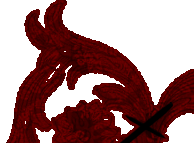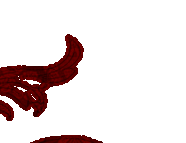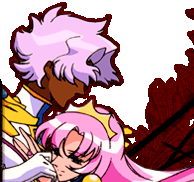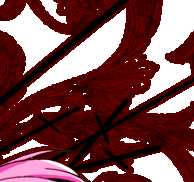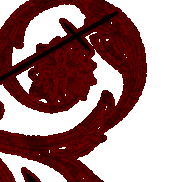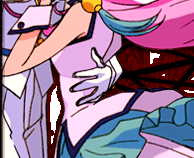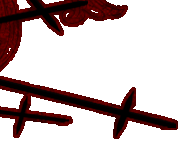
Cosmopolitan Designs in Salman Rushdie's 'The Enchantress of Florence'
and Hermann Hesse's 'Demian'
(Including an excursus on Kunihiko Ikuhara's anime-series 'Revolutionary Girl Utena')
This analysis
was donated by Meike Nederveld.  3 The Disciples of Abraxas Kim Anderson Sasser sees in Enchantress a "significant shift", entailing radical
changes in Rushdie's ways to employ hybridity and magic realism. Hybridity in
Rushdie's earlier work, she argues, has been functioning as challenging purisms
by celebrating the hotch-potch, mongrelism, and all-at-onceness of postcolonial
reality (Cf. Anderson Sasser, 140-142), magic realism being the appropriate
mode for this undertaking. In Enchantress, however, he proposes universal
cosmopolitanism instead of hybridity, radically departing from the idea of
celebrating the intermingling of peoples' cultural attachments in favor of
abandoning these attachments. Her argument is based on the observation of the
novel's moral evaluations of different modes of belonging: the particularist mode,
the nature of the world as one, and the exile's mode. In this chapter I would like
to propose a different reading of the latter two in the light of the similarities
between Enchantress and Demian, as the nature of the world as one filled with
meaningful synchronicity and exile as a semi-religious, exalted form of
belonging based on a particular predisposition.
 3.1 Shared Features and Differences in Hesse and Rushdie
While Enchantress is preoccupied with the topic of cosmopolitanism, its role in
Demian is a minor one. Their main shared feature can be summarized as the idea
of a shared human nature. Abraxas is a god of universalism, and Anderson Sasser
is indeed correct when she attests Rushdie a universalist worldview – at the base
of human nature, at least. With Demian, Hesse attempts to explore the very
foundation of what makes us human, the fundamental workings of the psyche,
and the popularity of the concept of human equality and shared human
psychological development at the time, exemplified by the publication of Freud's
“Totem und Tabu” (1913), leaves no other approach but the universalist one.
The Enchantress offers a far more complex picture, as its various characters are
all at some point confronted with the greater world, with strange encounters, or
with some form of exile. Rushdie also expands the Idea of the world “looking
like home” by constructing various similarities and mirrorings, such as Argalia's
returning to Florence mirroring Mogor's arrival in Sikri, or the house of Mars,
home to the skeletal whore “Scandal” and her antithesis, Materassina, mirrored in
the house of Skanda, the god of war, equivalent to Mars, home to the Skeleton
and her own fat-bodied antithesis.
Hesse's mysterious characters of Demian and Frau Eva both are ambiguous on
many levels. Demian is described as androgynous, like a grown man despite his
years, but with a certain androgyny to his face, “es war, als sei etwas von einem
Frauengesicht darin” (P. 61), neither young nor old, like an animal or a star. In his
dreams of Frau Eva, Sinclair is stricken with “Wonne und Grausen”, because she
is both his own mother and his friend Demian, charging her with the taboos of
incest and homosexual desire. Their religion, following the very god of
ambiguity, and the rumors of an incestuous quality to their relationship, also
makes them morally ambiguous. In a similar way, Qara Köz, Argalia, Akbar and
Mogor are ambiguous characters, morally, sexually and, in addition, with the
exception of Akbar, concerning their modes of belonging. Notably, Akbar's initial
reaction of love for Mogor (P. 71) is strikingly similar to Sinclair's affection for
Demian, and as Sinclairs attraction is later redirected to Demian's mother Frau
Eva, Akbar falls in love with Mogor's (supposed) mother Qara Köz.
The similarities of Qara Köz and Frau Eva do not end here. In fact, I would argue
that Qara Köz is, at least in part, modeled on Frau Eva:
Ich vermochte kein Wort zu sagen. Aus einem Gesicht, das [...] ohne Zeit und Alter,
und voll von beseeltem Willen war, lächelte die schöne, ehrwürdige Frau mir
freundlich zu. [...] Und nun blickte ich auf in die schwarzen, unergründlichen Augen,
[...] auf die freie, fürstliche Stirn, die das Zeichen trug. (P. 163-164, italics mine)
“Das Zeichen” is to say the “mark of Cain”, the sign shared by the followers of
Abraxas, the people who are different from those who “follow the herd”. It is not
a visible sign, but an outward manifestation of a certain mentality, and the people
who have it can recognize it in each other. Compare the following passage from
Enchantress:
In [Akbar's] tower's display of might the traveler recognized the same quality
of flamboyance that burned upon his own forehead like a flame, or a mark of
the Devil. (P. 8)
The idea of the mark10, and mutual recognition of it, offers an important insight
into Rushdie's cosmopolitanism, which I will discuss in the following chapter.
 3.2 Cosmopolitanism as Predisposition
I have established that the followers of Abraxas, bearers of the mark of Cain, are
special, and recognize each other. They share a sense of being destined to propel
social and individual (r)evolution. They choose exile and the severance of
conventional attachments in order to live as role models of new ways of living. In
this sense of mission they may differ from the characters of Enchantress, but this
can be attributed to the fact that while Demian is preoccupied with epistemics,
Enchantress focuses on (hi)stories, and the way they interconnect. Specialness
and a sense of destiny are also what drives the main characters in Enchantress,
bestowing them with magical powers. They recognize each other as well, share a
common plane of the mind, as in Qara Köz's mental dialogues, Akbars creation
of life through thought, Il Machia's glimpse of Akbar in a dream, and Mogor's
narrative framework.
They also share another feature, which also holds true for the followers of
Abraxas in Demian: none of them are of low birth. In Demian, all the characters
aligned with Abraxas have either french (Sinclair, Demian) or latin (Pistorius,
Beatrice) names. The ones on the other side, the unknowing or evil characters are
called “Kromer” or “Knauer”, more guttural names of german origin, with
connotations of the less refined, lower class. Sinclair and Demian also go to latin
school, and later university. Demian's mother is rumored to be very rich, and
Sinclair's family is not poor, either. The practical reason behind this class-based
exclusion from the order of Abraxas is one of resources. The working class
simply does not have the time and money to afford financing extensive education
of their children, or tolerating their wallowing in self-reflection, and their lives
depend on going “with the herd”. Enchantress paints a similar picture: “The
peasants, tied as if by ropes to land that was arid and dying, watched the great
procession leave.” (346) They cannot afford travel, and lack unique skills to
make them valuable enough for the mighty to bring along, and even being
brought along, like the whore Skeleton, is the best they can hope for. The aspect
of class thus adds another requirement to the cosmopolitanism of Abraxas: a
predisposition of nobility.
 3.3 Synchronicity and Psychology – The Influence of Carl Gustav Jung's Ideas
on Both Novels
Vijay Mishra has pointed out, that Rushdie's literature is permeated with
examples of numerology and synchronicity. The aspect of synchronicity, he
attributes to the influence of C.G.Jung's theories on Rushdie's body of work (Cf.
Mishra 401). In Jung's understanding, Synchronicity is a set of similar events
which are causally unconnected, and yet are not mere coincidences, but rather
connected through meaning, and meant to be interpreted as to their symbolic
meaning (Cf. Roth, 2002). As Mishra puts it, quoting Jung: “There is an 'acausal
orderedness'11 that permeates human life.”, and the writing of Rushdie (Mishra
401). Rushdie does not subscribe to this idea, however, but offers reader to
believe in it – or not. Mirroring events are either “meaningless coincidences or a
replay of archetypes” (Mishra 401).
Returning to Anderson Sasser's model of Rushdie's strategies of belonging, we
see that her interpretation of mirroring and doubling as a symptom of global
continuity is lacking an important aspect. Rather than simply a statement of
international continuity in the human race, which is doomed to re-create the same
forms in any culture – though a notion that Jung would support with his theories
on a collective subconscious which contains relics from every stage in human
evolution – mirroring events can also be read as guideposts along the way of the
characters toward their own self-realization, meaningful by their similarity and
simultaneity, and not as a causal result of a shared human nature. If anything, the
shared human nature this suggests would be that of the interpretation of signs, a
linguistic and translative effort, which, at its intersection, again creates the
hotchpotch, the hybrid, the blasphemy of the potato witches (Cf. Rushdie 212).
Jung's psychology also heavily informed Hesse's Demian. In his Article on
Demian in light of Jung's psychology, Günter Baumann interprets the novel as an
allegory of the psychological coming of age, which, in Jung's understanding,
requires confronting and internalizing certain symbolic archetypes. The most
prominent archetypes are the “Shadow” the outward projection of the Self's baser
drives, often onto versions of the Other, in Demian exemplified by the villain
Kromer (Cf. Baumann 5), the “Great Mother” often symbolized by an egg,
connoted with (spiritual) rebirth, and charged with the mystical because the
desire for it is inherently taboo, as it is incestuous (Cf. Baumann 7), in Demian
exemplified by Frau Eva, and the “Guide”, a version of the self one aspires to be,
also often projected on others (Cf. Baumann 10). Sinclair encounters these
archetypes, lets go of their outward projections, as he internalizes them, and
succeeds in his journey to the self. In this light, we can re-interpret Akbar's
failure: he rejects his Guide and instead wallows in the incestuous bond with the
Great Mother, and thus never achieves the true self – the “I”.
Go back to Index - Next Page

12 The manga by artist Chiho Saito focuses on different aspects of the story, and decidedly more
on the romance, which is a typical characteristic of shôjo (girl) manga.
13 Shôjo kakumei Utena, Adolescence Mokushiroku. Usually trans lated as "Adolescence of
Utena", echoing the sub-title of Hesse's Demian: "Die Geschichte von Emil Sinclairs Jugend".
14 Shôjo kakumei Utena makai tensei mokushiroku hen: reijin Nirvana raiga. Roughly
translatable as: Revolutionary Girl Utena Reborn in Hell: the Beauty of Nirvana Arrives.
15 Also written "Anthy". Himemiya can be translated as "Shrine of the Princess", which
simultaneously denotes her as a hollow thing in the form of a princess and points at her being
hidden away.
16 Mikage means "Noble Shadow", and Mamiya, though written "Horse Shrine" can also be
interpreted to mean "Devil Shrine" or "Magic(ian) Shrine", opening up the Dichotomy of
Devil/Witch and Prince/Princess.
17 They are not called that in the series, but the ideas of the Jungian archetypes of Shadow and
Persona permeate the individual narratives of the characters. This becomes nearly explicit as
Mikage's modus operandum includes psychoanalysis, and his counselling leads to the
characters embracing their antisocial tendencies, instead of masking them.
18 Japan has varying ages of consent, but considering media conventions, the mere fact that she
is 14 while he is much older would not make it rape, per se. The scene is, however, made to
appear as awkward as possible, to convey that while Utena does want it, she is not really
there, not really ready, and being utilized towards an end.
19 This is even more clear in the movie, in which Utena is transformed into a car, which Anshi
drives through a deadly racetrack. Right before the finish line, they face the phantom of Akio
– in the movie already dead, killed by the "witch" - who crushes the car in a giant press, but
Utena and Anshi break through Akio's chest, and he dissolves, while they, naked and on only
two wheels, escape the school into the desolate outside world, where they finally kiss. The
shell of the self is in this case the car's , and the final shell to be broken.
20 Cf. http://ja.wikipedia.org/wiki/少女革命ウテナ. Sadly aside from this there are only a few
blog posts which analyze shared themes and infer this (the parallels are obvious enough). The
consensus of japanese viewers on the subject seems based on a widespread knowledge of
Hesse's literature, and probably on an interview with Ikuhara, in which he mentioned Hesse.
Due to different priorities and customs in the japanese language internet, tracing this
knowledge from germany is extremely difficult.
21 Although there is a bird at the center of Utena: the Ôtori, which means "Phoenix", in Ôtori
Academy.
22 The movie has Tôga additionally be the victim of sexual abuse at the hands of his stepfather
23 Nanami is quite probably modeled after the depiction of the young Marie Antoinette in
Riyoko Ikeda's Rose of Versailles, the "mother of all Shôjo Manga".
24 In the movie, it becomes even more clear that she also switches sexual allegiance, while in the
series it is just implied that whoever wins her can do "anything they want" with her.
  |

